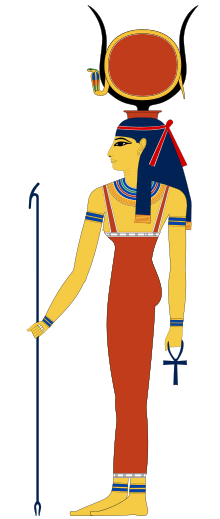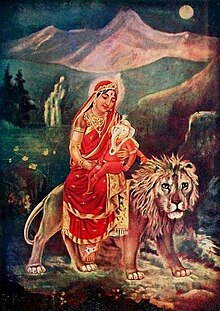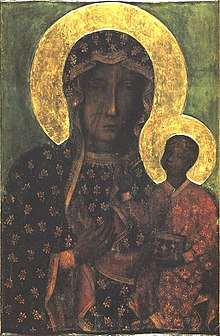| Ọ̀ṣun Oshun | |
|---|---|
Love, Beauty, Intimacy, Freshwater, Osun River, Wealth, Diplomacy | |
| Member of the Orisha | |
 | |
| Other names | Ochún, Oxúm |
| Venerated in | Yoruba religion, Dahomey mythology, Vodun, Santería, Candomblé, Haitian Vodou |
| Region | Nigeria, Benin, Latin America, Haiti, Cuba |
| Ethnic group | Yoruba people, Fon people |
| Personal information | |
| Spouse | Changó, Erinle |
Ọṣun, is an orisha, a spirit, or a deity that reflects one of the manifestations of the Yorùbá Supreme Being in the Ifá oral tradition and Yoruba-based religions of West Africa.[1] She is one of the most popular and venerated Orishas. Oshun is an important river deity among the Yorùbá people. She is the orisha of divinity, femininity, fertility, beauty and love.[2][3] She is connected to destiny and divination.[4]
During the life of the mortal Osun, she served as queen consort to King Shango of Oyo. Following her posthumous deification, she was admitted to the Yoruba pantheon as an aspect of a primordial divinity of the same name.
She is the patron saint of the Osun River in Nigeria, which bears her name. The river has its source in Ekiti State, in the west of Nigeria, and passes through the city of Osogbo, where Osun-Osogbo Sacred Grove, the principal sanctuary of the deity, is located.[2] Oṣun is honored at the Osun-Osogbo Festival, a two-week-long annual festival that usually takes place in August, at the Oṣun-Osogbo Sacred Grove on the banks of the river.[5][6]
Oṣun is one of the 401 Yoruba orishas.
https://en.wikipedia.org/wiki/Oshun
Erzulie (sometimes spelled Erzili or Èzili) is a family of loa, or spirits, in Voodoo.
https://en.wikipedia.org/wiki/Erzulie
In Greek mythology, the Charites /ˈkærɪtiːz/ (Χάριτες [kʰárites]), singular Charis, or Graces, were three or more goddesses of charm, beauty, nature, human creativity, goodwill, and fertility.[1] Hesiod names three – Aglaea ("Shining"), Euphrosyne ("Joy"), and Thalia ("Blooming")[2][1] – and names Aglaea as the youngest and the wife of Hephaestus.[3] In Roman mythology they were known as the Gratiae, the "Graces". Some sources use the appellation "Charis" as the name of one of the Charites, and equate her with Aglaea, as she too is referred to as the wife of Hephaestus.[4]
The Charites were usually considered the daughters of Zeus and Oceanid Eurynome.[2] Rarely, they were said to be daughters of Dionysus and Coronis[5] or of Helios and the Naiad Aegle[6][7] or of Hera by an unnamed father.[8] Other possible names of their mother by Zeus are Eurydome, Eurymedousa, or Euanthe.[9] Homer identified them as part of the retinue of Aphrodite. The Charites were also associated with the Greek underworld and the Eleusinian Mysteries.
In post-classical painting and sculpture, the three Charites are often depicted naked or almost naked, but during the Archaic and Classical periods of Greece, they were typically depicted as fully clothed.[1]
https://en.wikipedia.org/wiki/Charites
| Hathor | |||
|---|---|---|---|
 Composite image of Hathor's most common iconography, based partly on images from the tomb of Nefertari | |||
| Name in hieroglyphs | Egyptian: ḥwt-ḥr
| ||
| Major cult center | |||
| Parents | Ra | ||
| Consort | |||
| Offspring | Ihy, Neferhotep, Ra (cycle of rebirth) | ||
Hathor (Ancient Egyptian: ḥwt-ḥr, lit. 'House of Horus', Ancient Greek: Ἁθώρ Hathōr, Coptic: ϩⲁⲑⲱⲣ, Meroitic: 𐦠𐦴𐦫𐦢 Atri/Atari) was a major goddess in ancient Egyptian religion who played a wide variety of roles. As a sky deity, she was the mother or consort of the sky god Horus and the sun god Ra, both of whom were connected with kingship, and thus she was the symbolic mother of their earthly representatives, the pharaohs. She was one of several goddesses who acted as the Eye of Ra, Ra's feminine counterpart, and in this form she had a vengeful aspect that protected him from his enemies. Her beneficent side represented music, dance, joy, love, sexuality, and maternal care, and she acted as the consort of several male deities and the mother of their sons. These two aspects of the goddess exemplified the Egyptian conception of femininity. Hathor crossed boundaries between worlds, helping deceased souls in the transition to the afterlife.
https://en.wikipedia.org/wiki/Hathor
| Shapi Leima | |
|---|---|
Goddess of rodents | |
| Member of Lairembis | |
 Goddess Shapi Leima | |
| Other names |
|
| Affiliation | Meitei mythology (Manipuri mythology) and Meitei religion (Sanamahism) |
| Animals | rodents |
| Symbols | rodents |
| Gender | Female |
| Region | Manipur, Northeast India |
| Ethnic group | Meitei ethnicity |
| Festivals | Lai Haraoba |
| Personal information | |
| Parents | Salailen (Soraren) |
| Siblings | Khunu Leima and Nganu Leima |
| Term | |
|---|---|
| English | Shapi Leima |
| Ancient Meitei | ꯁꯄꯤ ꯂꯩꯃ (sa-pee lei-ma) |
| Modern Meitei | ꯁꯕꯤꯔꯩꯃ (sa-bee-rei-ma) |
| Assamese | শবী লৈমা / শবীৰৈমা (sha-bee lei-ma / sha-bee-rei-ma) |
| Bengali | শবী লৈমা / শবীরৈমা (sha-bee lei-ma / sha-bee-rei-ma) |
| Hindi | शपी लैमा / शबी लैम (sha-pee lei-ma / sha-bee lei-ma) |
| Sanamahism | |
| Part of a series on |
| Meitei mythology |
|---|
 |
|
|
|
|
|
|
|
|
|
|
| Part of a series on |
 |
| Sanamahism |
| Category |
| Primordial deities |
|---|
| Saiyon Langgon |
| Religious texts |
| Religious Symbolism |
|
| Ancient Sites in Manipur |
| List of figures in Meitei mythology |
| Religious roles |
| Religious buildings & institutions |
| Religious festivals |
| Lai Halaopa and its holy dances |
| Sanamahism & other religions |
| Related topics |
Shapi Leima (Shabi Leima) or Sapi Leima (Sabi Leima) is the goddess of rodents in Meitei mythology and religion. She is a sister of goddesses Khunu Leima and Nganu Leima. Legend says that all three sisters married the same mortal man.[1][2][3][4][5][6]
https://en.wikipedia.org/wiki/Shapi_Leima
Prende (also Prenne, Prema, Premte, or Petka) is the dawn-goddess, goddess of love, beauty, fertility, and protector of women, in the Albanian pagan mythology.[2] She is also called Afërdita or Afrodita, a phrase meaning "come forth the day/dawn" in Albanian,[3] in reference to Hylli i Dritës, Afêrdita "the Star of Light, Afêrdita" (i.e. Venus, the morning star)[4] and to Ylli i Mbrëmjes, Afërdita (i.e. Venus, the evening star).[5] According to some Albanian traditions, Prende is the daughter of Zojz, the Albanian sky and lighning god.[6]
https://en.wikipedia.org/wiki/Prende
| Parvati | |
|---|---|
Mother Goddess[1] Goddess of Power, Nourishment, Devotion, Motherhood, Fertility, and Harmony[2] Supreme Goddess in Shaivism Para Brahman the Supreme Being | |
| Member of Tridevi | |
 Parvati with her son Ganesha | |
| Other names | Sati, Uma, Gauri, Durga, Kali, Aparna, Girija, Haimavati, Shankari, Maheshvari, Mariamman |
| Sanskrit transliteration | Pārvatī |
| Devanagari | पार्वती |
| Affiliation | Mahadevi, Tridevi, Sati, Durga, Kali, Mahakali, Tripura Sundari |
| Abode | Mount Kailash, Manidvipa |
| Mantra | Om Pārvatyāi Namaha |
| Mount | Lion and Tiger |
| Texts | Devi-Bhagavata Purana, Devi Mahatmya, Kalika Purana, Shakta Upanishads, Tantras |
| Festivals | Navaratri, Vijayadashami, Teej, Bathukamma, Gowri Habba, Durga Puja, Kali Puja |
| Personal information | |
| Parents | |
| Siblings | |
| Consort | Shiva |
| Children | Ganesha (son) Kartikeya (son) Ashokasundari (daughter) |
| Equivalents | |
| Indo-European equivalent | Priyah |
| Part of a series on |
| Shaktism |
|---|
 |
|
|
|
|
|
|
|
|
|
|
|
|
|
|
Parvati (Sanskrit: पार्वती, IAST: Pārvatī), Uma (Sanskrit: उमा, IAST: Umā) or Gauri (Sanskrit: गौरी, IAST: Gaurī) is the Hindu goddess of power, energy, nourishment, harmony, love, beauty, devotion, and motherhood. In her complete form, she is a physical representation of Mahadevi, also known as Adi Shakti, the primordial power behind the creation of the universe, the creator and destroyer.[7][8] She is one of the central deities of the goddess-oriented sect called Shaktism, and the supreme goddess in Shaivism. Along with Lakshmi and Saraswati, she forms the Tridevi.[9]
https://en.wikipedia.org/wiki/Parvati
| Lakshmi | |
|---|---|
| Member of Tridevi and Panch Prakriti | |
 Sri Gaja Lakshmi by Raja Ravi Varma (1896) | |
| Other names | Bhargavi, Kamala, Narayani, Padma, Sri |
| Devanagari | लक्ष्मी |
| Affiliation | |
| Abode | Vaikuntha, Manidvipa |
| Mantra | ॐ श्रीं श्रियें नमः। (Om̐ Śrī Sriyem̐ Namah), ॐ श्रीं महालक्ष्म्यै नमः। (Om̐ Śrīm̐ Mahālakṣmyai Namaha), ॐ श्री महालक्ष्म्यै नमः। (Om̐ Śrī Mahālakṣmyai Namah) |
| Symbols | Padma (Lotus), Shankha (conch), Discus, Gada (mace), Jnana Mudra, Abhaya Mudra, Varadamudra, Gold. |
| Tree | Tulsi |
| Day | Friday |
| Mount | Garuda, owl, elephant, lion |
| Festivals | Deepavali (Lakshmi Puja), Sharad Purnima, Varalakshmi Vratam, Navaratri, Sankranti[5] |
| Personal information | |
| Siblings | Jyestha or Alakshmi, Chandra |
| Consort | Vishnu[9] |
| Children | • Kamadeva[6]
• Bala and Utsaha (Vayu Purana)[7] • Kardama, Chiklita, and 16 other sons (18 sons) (Rigveda)[8] |
| Translations of लक्ष्मी (Lakṣmī) | |
|---|---|
| Sanskrit | लक्ष्मी (Lakṣmī) |
| Assamese | লক্ষ্মী (Lakṣmī) |
| Bengali | লক্ষ্মী (Lakṣmī) |
| Bhojpuri | {{{bho}}} |
| Hindi | लक्ष्मी (Lakṣmī) |
| Kannada | ಲಕ್ಷ್ಮೀ (Lakṣmī) |
| Marathi | लक्ष्मी (Lakṣmī) |
| Odia | ଲକ୍ଷ୍ମୀ (Lakṣmī) |
| Tamil | லக்ஷ்மீ (Lakṣmī) |
| Telugu | లక్ష్మీ (Lakṣmī) |
| Gujarati | લક્ષ્મી (Lakṣmī) |
| Glossary of Hinduism terms | |
Lakshmi (/ˈlʌkʃmi/;[10][nb 1] Sanskrit: लक्ष्मी, romanized: Lakṣmī, sometimes spelled Laxmi, lit. 'she who leads to one's goal'), also known as Shri (Sanskrit: श्री, romanized: Śrī, lit. 'Noble'),[12] is one of the principal goddesses in Hinduism. She is the goddess of wealth, fortune, power, beauty, fertility and prosperity,[13] and associated with Maya ("Illusion"). Along with Parvati and Saraswati, she forms the Tridevi of Hindu goddesses.[14]
https://en.wikipedia.org/wiki/Lakshmi
| Kounu | |
|---|---|
Guardian Goddess of North Weather Goddess | |
| Member of Maikei Ngaakpa Lais | |
 "Kounu", the name of the goddess, written in archaic Meetei Mayek abugida | |
| Other names | Kounoo |
| Affiliation | Meitei mythology (Manipuri mythology) and Meitei religion (Sanamahism) |
| Major cult center | Mount Kounu and Mount Koubru |
| Abodes | Mount Kounu and Mount Koubru |
| Gender | Female |
| Region | Ancient Kangleipak (Ancient Manipur) |
| Ethnic group | Meitei ethnicity |
| Festivals | Lai Haraoba |
| Personal information | |
| Consort | Koupalu (Koubru) |
| Children | Loyalakpa, Thoudu Nungthel Leima |
| Term | |
|---|---|
| English | Kounu |
| Ancient Meitei | ꯀꯧꯅꯨ ꯂꯥꯢꯂꯦꯝꯄꯤ (kou-noo lai-lem-pee) |
| Modern Meitei | ꯀꯧꯅꯨ ꯂꯥꯢꯔꯦꯝꯕꯤ (kou-noo lai-rem-bee) |
| Assamese | কৌনু লাইৰেম্বী (kou-noo lai-rem-bee) |
| Bengali | কৌনু লাইরেম্বী (kou-noo lai-rem-bee) |
| Hindi | कौनू / कौनु (kou-noo) |
| Sanamahism | |
| Part of a series on |
| Meitei mythology |
|---|
 |
|
|
|
|
|
|
|
|
|
|
| Part of a series on |
 |
| Sanamahism |
| Category |
| Primordial deities |
|---|
| Saiyon Langgon |
| Religious texts |
| Religious Symbolism |
|
| Ancient Sites in Manipur |
| List of figures in Meitei mythology |
| Religious roles |
| Religious buildings & institutions |
| Religious festivals |
| Lai Halaopa and its holy dances |
| Sanamahism & other religions |
| Related topics |
Kounu is a goddess in Meitei mythology and religion of ancient Kangleipak (ancient Manipur). She is a consort of the god Koupalu.[1][2] She is the guardian of the northern direction.[3] Kounu has two homes. Her main home is on Mount Kounu. Her other home is in Mount Koubru, which is where her husband Koupalu (Koubru) lives.[1] She is worshipped with Koubru as the deities of the Khullakpa (village chief).[4] Kounu and Koubru ruled ancient Manipur for a very long time after the reign of King Ningthou Puthiba.[5]
https://en.wikipedia.org/wiki/Kounu
| Nefertem | ||||||
|---|---|---|---|---|---|---|
 the Memphite god Nefertem with a water-lily headdress as a symbol of fragrance and beauty. | ||||||
| Name in hieroglyphs |
| |||||
| Major cult center | Memphis | |||||
| Symbol | the water-lily, lion (occasionally) | |||||
| Parents | Ptah and Sekhmet or Bast | |||||
Nefertem (/ˈnɛfərˌtɛm/; possibly "beautiful one who closes" or "one who does not close"; also spelled Nefertum or Nefer-temu) or in Coptic ⲛⲉϥⲧⲏⲙ was, in Egyptian mythology, originally a lotus flower at the creation of the world, who had arisen from the primal waters.[2] Nefertem represented both the first sunlight and the delightful smell of the Egyptian blue lotus flower, having arisen from the primal waters within an Egyptian blue water-lily, Nymphaea caerulea. Some of the titles of Nefertem were "He Who is Beautiful" and "Water-Lily of the Sun", and a version of the Book of the Dead says:
Rise like Nefertem from the blue water lily, to the nostrils of Ra (the creator and sungod), and come forth upon the horizon each day.
Nefertem was eventually seen as the son of the creator god Ptah, and the goddesses Sekhmet and Bast were sometimes called his mother. In art, Nefertem is usually depicted as a beautiful young man having blue water-lily flowers around his head. As the son of Bastet, he also sometimes has the head of a lion or is a lion or cat reclining. The ancient Egyptians[specify] often carried small statuettes of him as good-luck charms.
One of the most notable depictions of Nefertem is the Head of Nefertem, a wooden bust depicting a young king Tutankhamun as Nefertem with his head emerging from a lotus flower.
https://en.wikipedia.org/wiki/Nefertem







No comments:
Post a Comment